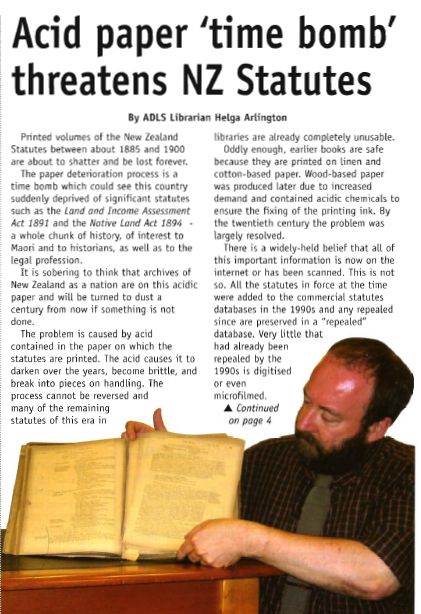Beating the brittle with digital
Posted on 09 September 2009 by Thomasin
In the darkened shelves or back rooms of many libraries sit a set of old nineteenth century law books that are seldom allowed into the public eye. Although New Zealand's paper stocks have generally been of a better quality than in the U.S., for a period through the 1880s and 1890s our law statutes were printed on low quality acidic paper. Today these are so brittle that just turning the pages of many editions causes them to crumble. They hit the headlines in 2004 after an Auckland District Law Society article led to them being nicknamed the "shattering statutes", and it wasn't long before digitisation was being promoted as a solution.

Law News article, Auckland District Law Society, February 2004
For a time it was unclear who was responsible for maintaining these law books. The National Library and Alexander Turnbull Library had dealt to some extent with the preservation issues by keeping sets in climate controlled environments, but these were difficult to access. Other libraries around the country were finding it hard to maintain undamaged copies, yet did not have the resources to digitise them. As a result, the number of available copies was rapidly dwindling. Enter the Parliamentary Counsel Office, the agency responsible for drafting and publishing New Zealand Acts of Parliament and statutory regulations. The Parliamentary Counsel Office as far back as 2000 had established the Public Access to Legislation (PAL) project. Following the sale of Government Print in the late 1990s, PAL was intended to ensure that public access to legislation could still be maintained and improved by the government through electronic provision. The Parliamentary Counsel Office also has a responsibility for continued provision of official reprinted paper volumes, but not historical legislation. The shattering statutes were recognised as a special case and natural candidates for reprinting. But in order to reprint them digital copies had to be made as a first step. This aligned nicely with the efforts to get current legislation accessible online. An assessment by the National Library identified that the years 1888 to 1894 were at the highest risk of loss due to acidity. These Acts include significant land legislation of interest to the Waitangi Tribunal, as well as historic laws such as the 1893 Electoral Act giving New Zealand women the vote, the 1894 Middle District of New Zealand University College Act, which established a university in Wellington, and the 1894 Destitute Persons Act, which among other things made fathers responsible for the maintenance of their legitimate and illegitimate children. Given their brittle condition, there was no easy way to copy individual editions for reprinting. The National Library stepped in to microfilm the legislation, which enabled the creation of a preservation copy as well as a source for digital images to be made. It wasn't all straightforward though. Law library practice is to annotate law books with inserts as law changes are made, rather than reprint and rebind an entire Act each time. Finding unannotated original versions of statutes this old for copying took some effort, and some even had to have their annotations carefully removed by hand to get a clean copy. In order to get a satisfactory printed result, missing detail on the pages was restored manually on the digital versions. Column line breaks and brackets were re-done, while the Crown crests were scanned at a higher quality greyscale in order to preserve detail. Unlike some similar efforts overseas, care was taken to preserve marginalia notes, making them useful for historical as well as legal reference. This meant page by page checking and correcting to get the quality desired for reprinting. Digital scans of the microfilms were output to PDF for printing, with the PDFs being compressed for use on the web. Because the original aim was a reprint, the scans were not processed for OCR (Optical Character Recognition), meaning the current web versions are not searchable. However, each Act is indexed by name and year on the Knowledge Basket website where they are being hosted. It is hoped that fully accessible and searchable versions can be created as a next step. The shattering statutes are an interesting example of the need to select content carefully when resources are scarce, one of the purposes of our Make it Digital scorecard. The Parliamentary Counsel Office clearly identified that their goal was to produce a faithful facsimile representation of the statutes sufficient to be accessed as an alternative to the originals preserved by the Alexander Turnbull Library. The project was a priority due to the scarcity of copies in libraries, the difficulty accessing the paper versions without damage, and the continued demand by lawyers and historians for access. Because of their condition, microfilming (which avoids contact with the pages) followed by scanning of the film was the best digitisation approach. How access to the remaining body of historical legislation is dealt with is yet to be answered. In part this will be subject to the response to recommendations of the Law Commission when the government considers them later in the year. Further information about the project and links to the Law Commission's report can be found on the Parliamentary Counsel Office's website.
We've turned off comments here, but we'd still love to know your thoughts. Visit us on our Facebook Page @digitalnz or on Twitter @DigitalNZ to share any ideas or musings with the DigitalNZ team.